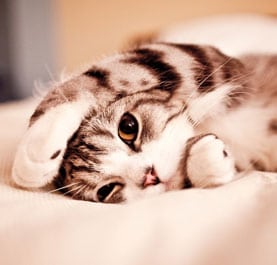 Cat Fostering Procedures
Cat Fostering Procedures
Purpose of Foster Care
Our main need for foster homes is during the spring and summer months for mum cats with kittens or pregnant cats, but we occasionally need foster homes for adult cats that require intensive care for health or behavioural reasons or where there is an emergency intake (eg death of an owner)
Becoming a Foster Carer
In order to become a foster carer you need to meet the following criteria:
- Be/have been an experienced cat owner
- Have a spare indoor room away from any of your own pets (if applicable)
- Have your own cats fully up to date with vaccinations
- Be within 20 miles or minutes’ drive of the sanctuary (or our current vets in Altrincham) your own transport is essential – we do not allow animals to be transported on public transport
- Be able to collect and return cats to the SAA at the start and end of the foster placement
- Be able to travel to & from the vets for routine and emergency appointments
If you meet the above criteria and wish to discuss fostering more please complete a cat fostering application form. Once we receive this application form you will be contacted to discuss in further detail, if you are successful a member of animal care will arrange to conduct a home visit. This is to have discussion in greater depth answering any questions you may have and to assess your facilities and experience.
Allocation of Cats to Foster Homes
Decisions to allocate cats to foster homes on our approved list will be made by the Animal Care Staff. Eligible cats will be allocated to foster care based on decisions made between animal care staff and fosterer’s about the individual cat’s needs and fosterer’s facilities and experience. When a cat(s) needs to be placed in foster care the fosterer will be contacted, most likely by telephone, and asked if they can take the cat on at that time. If they can assist they will be given, if possible, an indication of the planned duration of foster placement and an appointment made for them to either collect the cat(s) or have the cat(s) brought to their home.
Equipment and Supplies
The SAA will provide basic equipment, including a carrier, bedding, litter tray, litter scoop, litter, bowls, food, toys and a scratch post. Fosterers may use their own equipment if they wish providing any cats in their home are healthy. The equipment provided is to be used for SAA cats only and unless a new cat is to be placed there in the near future the equipment should be returned to the SAA. Fosterers are responsible for visiting the sanctuary to obtain additional supplies as needed, with prior notice by telephone to ensure the items are available. If the foster carer cannot travel to the sanctuary they should give sufficient notice, by telephone, for the items to be delivered.
Quarantine and Mixing with Other Cats
Cats placed in foster care will not be permitted to go outdoors, or mix with any of the fosterer’s own cats. Fosterers therefore need to have a separate space where the foster cat(s) can be adequately housed; this will be agreed at the assessment visit. Other cats in the home must be neutered and fully vaccinated; proof of vaccination will be asked for at the assessment visit. This ensures cats complete their quarantine period in the foster home so they will be immediately up for adoption upon arrival at the SAA.
Preventative Health Care
The cat(s) will be wormed and flea treated before entering foster care, however fosterers may be required to administer repeat treatments. Many foster cats will not have received vaccinations prior to entering foster homes due to either due to age (nursing mums & kittens cannot be vaccinated until the kittens are at least 9 weeks old) or for health reasons. We do ask that foster carers take the cat(s) to the vets for their vaccinations and guidance on when this needs to be done will be given by the animal care staff. If the fosterer cannot do this they should speak to a member of staff to make alternative arrangements. An appointment will be made at the vets by a member of SAA staff at a time convenient for the fosterer. If an unneutered cat(s) is in foster care, they may need to be neutered whilst in their foster home, again advise should be sought from animal care on a case by case basis.
Medication
If a cat is on medication whilst in foster it is the fosterers responsibility to administer this.
Veterinary Treatment
If a foster carer has any concerns about the cat(s) in there care the first step is to contact a member of animal care staff. If they cannot be contacted the next point of contact is the general manager. They will advise you on the situation and what to do next. Animals may only be taken to our current vets, or their appointed out of hours service, for treatment. We will advise on whether and when treatment is necessary and contact the vet. In emergency situations and outside SAA hours (8:30 to 5:30) the foster carer will be responsible for transporting the animal to the vets. If you are unable to contact the animal care staff or manager you may make contact directly with the vets, but only if you are unable to contact someone at the SAA first.
Full contact details and opening hours will be given upon satisfactory home assessment visit.
Rehoming
Cats placed in foster care will be returned to the sanctuary at the appropriate time for rehoming. Fosterers are responsible for transporting the cat back to the SAA where possible. This protects the fosterers from the intrusion into their home of strangers and the potential health and safety associated with this.If a friend or family member expresses an interest in adopting a cat the fosterer must contact the SAA to discuss this and provide their contact details. A home check will then be carried out in line with our usual adoption procedures, the adopter would have to visit the sanctuary to complete the paperwork and pay the adoption fee. Then could then collect the cat directly from the foster home, if the fosterer agrees with this.
What if things go wrong?
If you experience difficulties with a cat(s) we have placed with you, please contact the SAA for advice. If there is a reason why a cat(s) cannot remain in the foster home, alternative arrangements will be made as quickly as possible.
Use of contact Numbers
The mobile phones numbers provided are for your use only, in relation to fostering. Please do not give these numbers to anyone else (other than the vets) and think before calling during evenings, the use of these numbers at evening should be limited to emergencies only.

